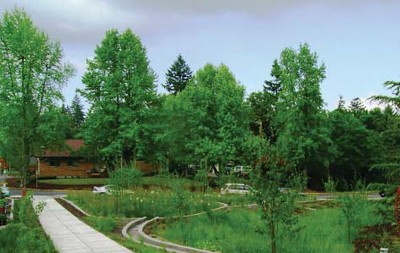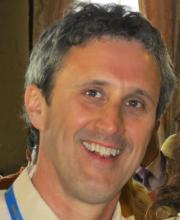The United States faces a massive infrastructure deficit and needs to invest some $3.6 trillion on infrastructure by 2020, mostly just to keep our nation’s energy, transportation, water, and waste systems – the vital circulatory systems of our society – in working order, according to experts.
Will we spend that money reflexively, according to the 20th Century playbook, and lock in inefficient, carbon-polluting systems for decades to come? Or will we invest in innovative projects and programs better adapted to a world with too much carbon and serious constraints on the public purse?
Developing innovative solutions for our massive public works challenges is the focus of the new Center for Sustainable Infrastructure at The Evergreen State College. Based at the college’s Olympia campus, the Center was launched in December to link regional innovators, advocate sustainable best practices, and develop skilled professionals who can help shift billions of dollars in public works investment to climate-smart infrastructure.
Urgent Need to Transform
There is urgent need to bring world-class innovation and new tools to our infrastructure planning and investment. To invest billions replicating the transportation, energy, water and waste systems we tolerate today would force the coming generation or two into too much dependence on fossil fuel and too little flexibility in the face of a destabilized climate.
There is a better way. Already a growing body of infrastructure innovators are demonstrating solutions that save money, pile on multiple benefits for human health and well-being, and increase community resilience in a changing world. The Northwest can be a national and global leader in sustainable infrastructure, and the Center will help to make that happen. In a world desperate for better ways to build infrastructure, our region can export the expertise to design these systems right – if we pioneer it on the ground here first.
In addition to being a clearinghouse for sustainable best practices and an advising center for agencies, utilities and tribes managing infrastructure, the Center for Sustainable Infrastructure is giving graduate students from Evergreen’s Master of Public Administration program opportunities to meet leading innovators, and research, analyze and even design new infrastructure strategies.
“At a time when huge investments in infrastructure are critical and when we need to find ways to moderate our environmental footprint, the work of the Center is of particular importance,” said Evergreen Provost and Vice-President for Academic Affairs Michael Zimmerman. “The opportunities it will provide for students to become involved in such groundbreaking research is truly exciting.”
What Will Sustainable Infrastructure Look Like?
The art and science of sustainable, climate-smart infrastructure is in its early development, but it promises to be more affordable, much less polluting, more resilient to weather extremes and other disasters, and more supportive of healthy communities. The practitioners at the cutting-edge are shifting infrastructure investments in these directions:
- Energy investments that center on energy efficiency, clean and renewable energy sources, district heating and cooling, energy storage, and an interactive, integrating “smart grid.”
- Transportation investments coupled with land use policies that concentrate housing, retail, and commercial activity around transit hubs, enable electric vehicles, grow the rail network for people and freight, support walking and biking, and infuse beauty, nature, safety and access for all income levels into the core of our communities.
- Stormwater, wastewater, and drinking water investments that center on resource-efficient designs and “green infrastructure” strategies that harness and enhance natural systems to get better results more affordably than relying first on bigger pipes, pumps, and treatment plants.
- Waste management investments and policies to transform wastes into resources through policies that incentivize better “upstream” product and package design, reuse-recycle systems that sustain materials in high value form, and systems to capture organic materials for energy production and soil regeneration.
- Bridging the silos that isolate planning for these sectors to design solutions that yield greater overall community benefits.
To pioneer new infrastructure approaches that deliver lasting value in the 21st century, policymakers and professionals will need a range of new tools, support, and services—from case studies of successful innovation, to new analytical tools and metrics, model policy frameworks, peer-to-peer networking, and more.
The Center, in collaboration with public, private and nonprofit partners, will build capacity in the region to develop and put to work these new tools and services. As a result, many billions of dollars will be invested more wisely in our neighboring communities, in the Pacific Northwest and beyond, and our region could emerge as a creative design epicenter for urgently-needed new approaches to building the vital circulatory systems of society.
Rhys Roth co-founded Climate Solutions in 1998 and left the organization in July 2013 to create the Center for Sustainable Infrastructure.

